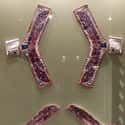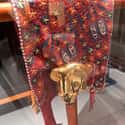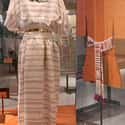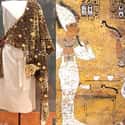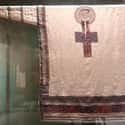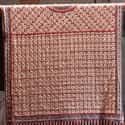-
(#9) The Mystery of the Wings
Tut's wings required more fashion sleuthing than his other clothing reproductions. Arthur Mace, who aided Howard Carter while excavating Tut's tomb, mistook them for ceremonial headdresses: “Found that so-called child's tippet' was really a head covering in the form of a protective bird with wings stretched out behind.” After reconstructing the four garments, Dr. Vogelsang-Eastwood and her students tried them on in different ways and discovered that they were upper armbands, not hats.
Tut wore these falcon wings of Horus in pairs, one on each arm with a wing draped over his front and one over his back so that his chest was completely enfolded. The Horus image may look printed onto the fabric, but the birds were constructed from individual pieces of red, blue, and white dyed linen sewn onto the base. Because the cuffs were extremely small, Tut either wore these wings when he was very young, or he had super skinny upper arms.
-
(#7) The Faux Leopard Cloak
This small, vegan leopard cloak was probably made for Tut right around the time that he was crowned pharaoh. There are cartouches just above the gold head that bear the king's coronation name, and a Horus falcon stretches diagonally in the center. The embroidered stars in circles covering the fabric – a similar design to those on the real leopard robe – meant that it was worn at the funeral of someone important. There's a chance that young Tut wore this leopard cloak while performing the “Opening of the Mouth” ceremony on his dad and predecessor, Akhenaten.
Why is this priestly garment made from a fake skin? Apparently, Tut and his priests wore both real and fake skins for religious ceremonies. Leopards weren't native to Egypt and arrived through suppliers from neighboring countries like Nubia, whose emissaries are shown bringing tributes to the pharaoh on one of the walls of Rekhmire's tomb. If anything disrupted the leopard-skin supply chain, priests and even the pharaoh had to get creative with their religious clothing.
-
(#1) The Tunic And Sash Combo
An ancient Egyptian tunic was made from a long sheet of linen sewn up the sides, with two holes left for arms and a large one cut in the middle for the head. The only accessories they had to hold this sheet together were sashes, which ranged from simple strips of cloth to tapestry-woven designs (right) and Amarna sashes.
A sheet and sash may sound like an easy Halloween costume, but the threads used to weave Tut's linen tunics were so fine and dense that it was difficult for the Borås Weaving School to reproduce the same sheer quality; the hand-spinning techniques needed to make such threads were quashed in most parts of the world by the Industrial Revolution. The weavers finally found linen of ancient Egyptian quality at a mill in Bergamo, Italy, where the world's top design houses go fabric shopping.
-
(#6) The Leopard Skin Robe
When Howard Carter found Tut's priestly robe, the leopard skin was severely decayed, so only the golden head and embellishments survived. It was a garment reserved for the pharaoh – the high priest of all the gods and temples in the land – and his Sem priests, who wore it while performing funerary rituals.
To the right is a painting from Tut's burial chamber that shows his successor, Ay, wearing a leopard robe while performing the “Opening of the Mouth” ceremony on Tut. In this ritual, Ay assumed the role of the god Horus and Tut the dead king Osiris. Once completed, Ay became king by divine approval, and Tut, with his mouth “opened,” was allowed to eat and drink in the afterlife, ensuring the 36 jars of red wine and 48 meat mummies in his antechamber wouldn't go to waste.
-
(#4) The “Syrian” Tunic
This was Tut's only garment with sleeves, designed for him when he was an early teen. His crowning name, “Nebcheperture,” is tapestry woven in cartouches around the collar along with images of the tree of life, a blessing for the young king, appear on both sides of the ankh sign in the middle of his chest. The bottom of the tunic is lined with panels depicting floral palmettes, griffins, sphinxes, and hunting scenes involving dogs, bulls, lions, gazelles, and ibexes. In order to reproduce this garment, the Borås Weaving School consulted Bedouins in Egypt who still spin thread on spindles and weave similar designs on looms that haven't changed in 4,000 years.
The "Syrian" tunic was most likely sent as a diplomatic gift from Egypt's longtime trading partner, the Mitanni Kingdom located in modern-day Syria and Angola, where sleeves were all the rage. In the end, this tunic was a sad souvenir to take into the afterlife. Though Tut sent his army to defend the fashion-forward Mitanni, they were crushed by invading Hittites right around the time that Tut died at the age of 19, obliterating the Mitanni Kingdom and throwing Tut's realm into chaos.
-
(#3) The Heb-Sed Outfit
This child-sized tunic says festival all over it. The repeating pattern of Heb-Sed hieroglyphs, most noticeable along the trim, shows that it was made specifically for Tut to attend the ruling pharaoh's jubilee celebration in Memphis, Egypt. It's the only one of Tut's garments that researchers can pin to a specific event, though it's unclear which pharaoh was celebrating his Heb-Sed. Most didn't arrange for the celebration until their 30th year of rule, though that didn't stop Tut's father, Akhenaten, who put on a Heb-Sed only three years into his reign.
Tiny Tut may have worn this garment while watching his old man prove he was still physically fit to rule by running eight times around a ritualistic track wearing nothing but the two crowns of Egypt, a short kilt, and a strapped-on bull's tail. To top off this royal track event, the pharaoh ran in the “company” of a real sacred bull named Apis.
New Random Displays Display All By Ranking
About This Tool
Affected by the creation of modern art, many people think that ancient Egyptian cities must be magnificent, and the costumes of ancient Egyptians must be gorgeous and diverse. In a longer historical period, the costumes of ancient Egypt from the pharaohs to the people were very simple, which can be proved by King Tut's ancient Egyptian clothing. The tomb of ancient Egyptian king Tut was discovered by archaeologists for more than 100 years, people have unearthed a large number of jewels and gorgeous funeral objects in his tomb, including many textiles.
Although they have been corroded and damaged, scientists have restored the color and appearance of these ancient costumes with the help of advanced technology. The random tool displays 12 amazing recreated garments from King Tut's ancient clothing.
Our data comes from Ranker, If you want to participate in the ranking of items displayed on this page, please click here.











